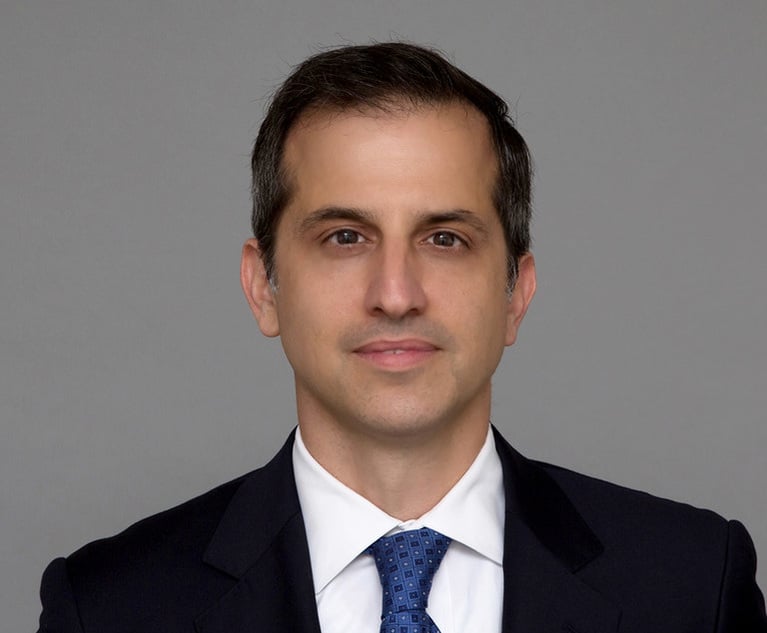Litigators of the Week: Defending Abortion Rights in the Age of COVID-19
"Pregnant women need healthcare, so forcing women to remain pregnant doesn't lead to any 'savings' of [personal protective equipment] or hospital beds. It only harms women."
April 24, 2020 at 12:06 AM
14 minute read
 Travis (T.J.) Tu of the Center for Reproductive Rights and Linda Goldstein Dechert. (Photo: Courtesy Photo)
Travis (T.J.) Tu of the Center for Reproductive Rights and Linda Goldstein Dechert. (Photo: Courtesy Photo)
Our Litigators of the Week are Dechert partner Linda Goldstein, Travis (T.J.) Tu of the Center for Reproductive Rights and Diana Salgado (not pictured) of Planned Parenthood.
The trio successfully challenged an executive order by Oklahoma's Governor Kevin Stitt that shut down all abortion services in the state, including the administration of medications for medication abortions. Stitt claimed the move was necessary to preserve the personal protective equipment and hospital beds needed to fight the COVID-19 pandemic.
Representing three of the four abortion clinics in Oklahoma, Goldstein (working pro bono), Tu and Salgada worked around the clock, filing a lawsuit in the Western District of Oklahoma to enjoin the order.
The case was assigned to a Trump appointee, U.S. District Judge Charles Goodwin. But Goodwin rejected the state's claims of unreviewable authority and issued a partial temporary restraining order that allowed the clinics to open their doors for medication abortions and pre-viable abortions later in pregnancy. The Tenth Circuit declined the state's interlocutory appeal, and Goodwin followed up with a preliminary injunction on Monday that greenlighted all abortion services in Oklahoma.
The trio discussed the case with Lit Daily.
Lit Daily: Tell us about the origins of the case and the moratorium issued by Oklahoma's Governor Kevin Stitt.
Linda Goldstein: On March 24, 2020, Oklahoma's governor issued an executive order mandating a moratorium on elective surgeries and minor medical procedures in the state in an effort to preserve the personal protective equipment (PPE) and hospital beds needed to fight the COVID-19 pandemic.
When asked by a reporter whether the moratorium covered abortion services, he responded that the details had not yet been worked out. Three days later, on Friday, March 27, the governor's office issued a press release that singled out abortion services for an absolute ban, including the administration of medications for medication abortions. Our clients had to shutter their doors and call panic-stricken patients to cancel their upcoming appointments.
Who are your clients?
T.J. Tu: Oklahoma has some of the harshest abortion restrictions in the country, and only four abortion clinics are left in the state. We represent Trust Women, a clinic in Oklahoma City, and Dr. Larry Burns, an abortion provider in Norman, Oklahoma.
Diana Salgado: Comprehensive Health of Planned Parenthood Great Plains is a trusted provider of reproductive health care. Among other services, Comprehensive Health provides abortion services in Arkansas, Oklahoma and Kansas. Its expert team of professionals is dedicated to offering all people high-quality, affordable sexual and reproductive health care. One in five American women has chosen Planned Parenthood for health care at least once in her life.
When and how did you three get involved?
T.J. Tu: I am co-counsel in the Center's ongoing challenge to a Louisiana law designed to shutdown abortion clinics in that state, which we argued before the U.S. Supreme Court the first week in March. I had just returned home to New York when word came that anti-abortion activists were encouraging states to exploit the COVID-19 crisis to ban abortions. Oklahoma was one of the first dominos to fall. We put together an amazing litigation team overnight and were in federal court with a TRO motion two days later.
Diana Salgado: As states began to use their COVID-19 executive orders as cover to ban abortion, Planned Parenthood Federation of America's litigation department worked in collaboration with other organizations that litigate to protect abortion access, including the Center for Reproductive Rights, to monitor these efforts across the country. When the governor of Oklahoma issued a press release announcing he would be banning abortion under his executive order against elective surgeries, T.J. and I quickly connected and knew immediately that we would have to go to court to protect abortion access in Oklahoma.
Linda Goldstein: I had written amicus briefs in two Supreme Court abortion cases, including the now pending Louisiana case, brought by the Center's clients, and had been speaking to them about opportunities for co-counseling in a case. This COVID-19 executive order case was a perfect chance to jump into the front line, and I was able to do that with support from a terrific Dechert team that included associates Samantha Rosa, Kathryn Barrett, Alyssa Clark and Julia Markham-Cameron.
What were your primary arguments when you sought the TRO?
T.J. Tu: Abortion care is time-sensitive essential healthcare. That's why leading medical groups, including the American College of Obstetricians and Gynecologists, have all said that abortion care should not be delayed or denied, even during the COVID-19 crisis.
Diana Salgado: As T.J. said, abortion is essential health care because of its time-sensitive nature. Imposing an unprecedented several-week delay on patients seeking an abortion would force those patients into having more complex procedures that would require more contact with the health care system than necessary.
We were also able to show that a pregnant person seeking an abortion but who is forced to continue the pregnancy under the governor's order likewise will require medical care that involves in-person contact and the use of PPE.
In sum, the district court correctly found that the purported "public health benefit achieved by delaying access to abortions 'do[es] not outweigh the lasting harm imposed by the denial of an individual's right to terminate her pregnancy' or 'by an undue burden or increase in risk on patients imposed by a delayed procedure.'"
Linda Goldstein: The legal arguments were pretty straightforward: that weeks of delay imposed an undue burden on all abortion patients and that, depending on the stage of their pregnancy, some would be denied their right to an abortion altogether. Both are unconstitutional under decades of Supreme Court precedent.
How did you cope with the compressed timeline?
T.J. Tu: Litigating a lightning fast, high-stakes case is challenging under any circumstances. Doing it from a spare bedroom in a pandemic is nuts. But don't feel bad for the lawyers. Countless patients' lives were turned upside down as a result of Oklahoma's abortion ban, and many were forced to travel to other states to obtain the care they need, a particularly harrowing experience during the current crisis.
Linda Goldstein: As in any expedited litigation, there were several simultaneous workstreams. The key is to marshal your resources and divide responsibilities up front so that each team can focus on specific tasks.
What extra challenges did working remotely present? Any lessons learned?
T.J. Tu: While many Americans stockpiled toilet paper, I was scrambling to order boxes of printer paper and toner cartridges online.
Diana Salgado: I have two young children and my partner also has a demanding legal career, so working from home has been very challenging. The speed at which this case has moved, the state's extraordinary efforts to appeal the TRO, and the fact that the governor continues to amend his orders has only made this case even more difficult to litigate during these times.
When I start to feel overwhelmed, I try to remember that there are people counting on our legal team to help them get the health care they desperately need. Many of the patients we're talking about are essential workers who make it possible for me and my family to stay home and out of harm's way.
Linda Goldstein: For me, the biggest challenge was repeatedly having to ask members of the fabulous Dechert team to work overnight or through the weekend by email, rather than by stopping by their offices or holding a team meeting in a conference room. I tried to address that with lots of ad hoc conference calls, but it was distinctly second-best.
Was amici support part of your strategy? Who weighed in and how did it happen?
Diana Salgado: After defendants appealed the district court's TRO to the U.S. Court of Appeals for the Tenth Circuit, the American College of Obstetricians and Gynecologists, the American Medical Association, and 16 other leading medical professional organizations and societies submitted an amicus brief in support of Plaintiffs-Appellees.
In their brief, the medical organizations attested that "[a]bortion is an essential component of comprehensive health care" and the medical community recognizes that "[a]ccess to legal and safe pregnancy termination . . . is essential to the public health of women everywhere." As such, the medical professionals noted that delays in care caused by Governor Stitt's executive order had "no medical justification" and would harm women and medical professionals.
New York and 17 other states, as well as the District of Columbia, also submitted an amicus brief in support of Plaintiffs-Appellees. The states' brief explained that "the time-sensitive nature of abortion care distinguishes that care from services that can be deferred without patient harm." The amici states also noted that a ban on abortion services in Oklahoma would likely encourage interstate travel and increase the risks of COVID-19 transmission; as such, "denying access to abortion care will not appreciably conserve hospital resources and [personal protective equipment]."
On April 3, U.S. District Judge Charles Goodwin held a telephonic hearing with counsel for both parties and amici. What was that like?
T.J. Tu: The entire team had pulled several all-nighters, so that first hearing is a bit of a blur. The judge came prepared, clearly understood the gravity of the case, and was cognizant of the challenging circumstances for the lawyers on both sides. Thankfully the hearing was by phone, not video, because I hadn't shaved in days and was arguing in sweatpants.
Goodwin, a Trump appointee, issued a TRO on April 6. What were some of the most notable aspects of his 14-page decision?
Linda Goldstein: Oklahoma had been urging the court that a 1905 Supreme Court decision (Jacobson v. Massachusetts) on the scope of state police power to address public health issues (in that instance, smallpox vaccination) required absolute deference to the governor's executive order. Judge Goodwin's decision did not adopt that argument but instead treated public health as part of the "state interest" to be considered in determining whether access to abortion could be delayed under Casey. It was the first decision to grapple with reconciling the two sets of precedents.
T.J. Tu: Most notable for me was that I got to call the clients and tell them constitutional rights are alive and well in Oklahoma. We are surrounded by bad news and misery right now, but there was joy in that moment.
The state immediately appealed to the Tenth Circuit. What happened?
Linda Goldstein: The state argued that the Tenth Circuit should take the immediate interlocutory appeal because if it didn't, COVID-19 patients would be turned away from hospitals that were treating women suffering complications from medication abortions. Since abortion is extremely safe, there was no actual evidence supporting that doomsday scenario. We urged the Tenth Circuit to reject the state's hypothetical claims of injury and dismiss the appeal of the TRO decision, which it did.
On Monday, Judge Goodwin issued a preliminary injunction. What were some highlights?
T.J. Tu: Oklahoma's contention that banning abortions will conserve healthcare resources ignored the reality that patients denied a wanted abortion remain pregnant. Judge Goodwin's decision shows that he clearly gets it: Pregnant women need healthcare, so forcing women to remain pregnant doesn't lead to any "savings" of PPE or hospital beds. It only harms women.
Linda Goldstein: One of the themes in the case was the gulf between the predictions of anticipated PPE shortages and hospital bed usage that the Attorney General was arguing in the state's briefs and the very different picture being painted in the governor's press conferences and Twitter feed, which portrayed large stockpiles of PPE and ample capacity of hospital beds. My favorite part of the preliminary injunction was the citation to one of the governor's tweets.
Oklahoma wasn't the only state to make moves restricting abortion access during the pandemic. Can you put your case in the larger national context? What are some common threads? What makes your case unique?
T.J. Tu: States that in recent years have moved aggressively to ban abortions in defiance of Roe v. Wade are the same ones now exploiting the pandemic to shutter abortion clinics. That's the common thread. But states like New York and California – which are at the epicenter of the crisis – have shown that it is possible to save lives and "flatten the curve" while maintaining abortion access and without throwing constitutional rights out the window.
Diana Salgado: Oklahoma is one of eight states that has tried to exploit the COVID-19 pandemic to push their political agenda to ban abortion. Elected officials should be focused on responding to the crisis at hand, not playing politics with people's health care. These same politicians have been eroding the public health infrastructure for decades. It's left many of these states fighting a pandemic with fewer hospitals, providers, and inadequate health insurance for people. These are the same states that have tried to ban abortion during past legislative sessions. It was no surprise they would use a pandemic as a political opportunity to take another swipe at reproductive health care.
Linda Goldstein: One of the common threads is the complete lack of any reputable medical evidence that would support banning abortion services during the pandemic. Plenty of states are permitting abortion services to proceed, and some states explicitly exempted abortion services from moratoriums on elective procedures. The executive orders banning abortion appeared to be a response to anti-abortion activists in the states that imposed them.
In Oklahoma, that was particularly transparent because of the way the ban was imposed by press release three days after the original executive order was issued. The state's Secretary of Health had no role in that press release, even though he had recommended the general moratorium.
What happens next? And what will you remember most about this case?
T.J. Tu: Priority number one is defending Judge Goodwin's preliminary injunction order on appeal. Priority two is sleep. I will remember that while the country went into lockdown, our team went into overdrive. And I'll never forget having a Zoom Passover dinner with my in-laws in one room while simultaneously having a Skype case team meeting in another.
Diana Salgado: We will continue to fight any effort by states to exploit the COVID-19 pandemic to push their political agenda to ban abortion. Our patients are counting on us to protect their rights during this public health crisis.
Linda Goldstein: This was trial by fire! T.J. and Diana had worked together before, but I had not worked with (or even met) either of them. The fact that we are able to work together as seamlessly as we do is just remarkable.
This content has been archived. It is available through our partners, LexisNexis® and Bloomberg Law.
To view this content, please continue to their sites.
Not a Lexis Subscriber?
Subscribe Now
Not a Bloomberg Law Subscriber?
Subscribe Now
NOT FOR REPRINT
© 2025 ALM Global, LLC, All Rights Reserved. Request academic re-use from www.copyright.com. All other uses, submit a request to [email protected]. For more information visit Asset & Logo Licensing.
You Might Like
View All
Firms Come Out of the Gate With High-Profile Litigation Hires in 2025

2024 Marked Growth On Top of Growth for Law Firm Litigation Practices. Is a Cooldown in the Offing for 2025?

Big Company Insiders See Technology-Related Disputes Teed Up for 2025

Litigation Leaders: Jason Leckerman of Ballard Spahr on Growing the Department by a Third Via Merger with Lane Powell
Law Firms Mentioned
Trending Stories
- 1States Accuse Trump of Thwarting Court's Funding Restoration Order
- 2Microsoft Becomes Latest Tech Company to Face Claims of Stealing Marketing Commissions From Influencers
- 3Coral Gables Attorney Busted for Stalking Lawyer
- 4Trump's DOJ Delays Releasing Jan. 6 FBI Agents List Under Consent Order
- 5Securities Report Says That 2024 Settlements Passed a Total of $5.2B
Who Got The Work
J. Brugh Lower of Gibbons has entered an appearance for industrial equipment supplier Devco Corporation in a pending trademark infringement lawsuit. The suit, accusing the defendant of selling knock-off Graco products, was filed Dec. 18 in New Jersey District Court by Rivkin Radler on behalf of Graco Inc. and Graco Minnesota. The case, assigned to U.S. District Judge Zahid N. Quraishi, is 3:24-cv-11294, Graco Inc. et al v. Devco Corporation.
Who Got The Work
Rebecca Maller-Stein and Kent A. Yalowitz of Arnold & Porter Kaye Scholer have entered their appearances for Hanaco Venture Capital and its executives, Lior Prosor and David Frankel, in a pending securities lawsuit. The action, filed on Dec. 24 in New York Southern District Court by Zell, Aron & Co. on behalf of Goldeneye Advisors, accuses the defendants of negligently and fraudulently managing the plaintiff's $1 million investment. The case, assigned to U.S. District Judge Vernon S. Broderick, is 1:24-cv-09918, Goldeneye Advisors, LLC v. Hanaco Venture Capital, Ltd. et al.
Who Got The Work
Attorneys from A&O Shearman has stepped in as defense counsel for Toronto-Dominion Bank and other defendants in a pending securities class action. The suit, filed Dec. 11 in New York Southern District Court by Bleichmar Fonti & Auld, accuses the defendants of concealing the bank's 'pervasive' deficiencies in regards to its compliance with the Bank Secrecy Act and the quality of its anti-money laundering controls. The case, assigned to U.S. District Judge Arun Subramanian, is 1:24-cv-09445, Gonzalez v. The Toronto-Dominion Bank et al.
Who Got The Work
Crown Castle International, a Pennsylvania company providing shared communications infrastructure, has turned to Luke D. Wolf of Gordon Rees Scully Mansukhani to fend off a pending breach-of-contract lawsuit. The court action, filed Nov. 25 in Michigan Eastern District Court by Hooper Hathaway PC on behalf of The Town Residences LLC, accuses Crown Castle of failing to transfer approximately $30,000 in utility payments from T-Mobile in breach of a roof-top lease and assignment agreement. The case, assigned to U.S. District Judge Susan K. Declercq, is 2:24-cv-13131, The Town Residences LLC v. T-Mobile US, Inc. et al.
Who Got The Work
Wilfred P. Coronato and Daniel M. Schwartz of McCarter & English have stepped in as defense counsel to Electrolux Home Products Inc. in a pending product liability lawsuit. The court action, filed Nov. 26 in New York Eastern District Court by Poulos Lopiccolo PC and Nagel Rice LLP on behalf of David Stern, alleges that the defendant's refrigerators’ drawers and shelving repeatedly break and fall apart within months after purchase. The case, assigned to U.S. District Judge Joan M. Azrack, is 2:24-cv-08204, Stern v. Electrolux Home Products, Inc.
Featured Firms
Law Offices of Gary Martin Hays & Associates, P.C.
(470) 294-1674
Law Offices of Mark E. Salomone
(857) 444-6468
Smith & Hassler
(713) 739-1250






